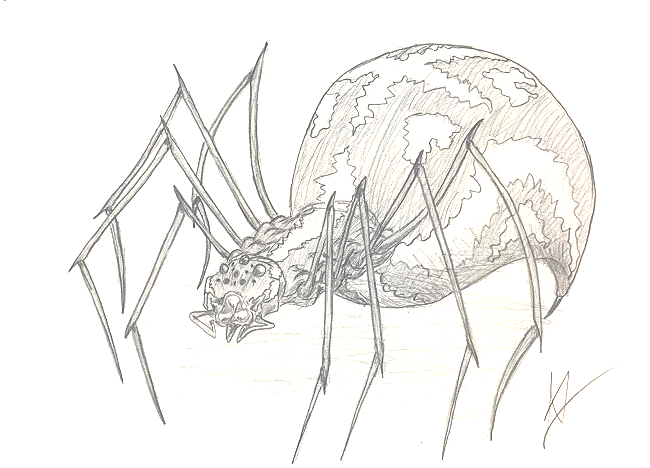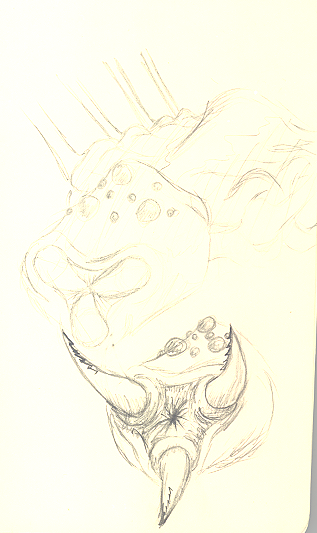|
Wizard Spider Information
The wizard spider (called "Magiqueira" in Brazil) is key, not only to the existence of the wizard community, but also to the study of a form of power that the rest of the world doesn't even know exists. And while the average wizard doesn't have to fully understand their spider in order to take advantage of it, it is clear that the closer we look at this mysterious creature, the more questions are raised.
|  |
| Diagram of a wizard spider - Cryptodectus Paranetus |
There are two primary substances of interest that are secreted by a wizard spider: saliva and venom. The silk from a wizard spider is rarely used and is not particularly noteworthy beyond being slightly stronger than many of the more common spiders. And the poison that is found in the wizard spider's stinger is instantly lethal to any wizard, but contains no other particularly noteworthy qualities. It kills by interacting with and mutating the spider venom found in a wizard's circulatory system. However, to an unconverted person, it causes a reaction little more than a bee sting.
While it was once believed that the venom of the wizard spider was what stimulated the growth of the magic gland, through experimentation and study, it has been determined that it is in fact the saliva that induces growth. The venom, however, appears to be used for the purpose of expressly protecting a wizard from overt magic attacks on the body of the wizard.
It was Leth, Kade's predecessor as director, who made the discovery regarding the spider saliva. The discovery occurred shortly before he was about to step down and hand the reins over to Kade in October, 2003.
However, there has been no indication that wizard type has any link with the spider. While it is true that each spider seems to be drawn to and compatible with specific individuals only, it would appear that the kind of wizard a subject will become is more closely tied to that individual's genetic profile than it is to any specific trait of the spider. And even if a wizard spider were to bite a human to which it had not been expressly attracted, the magic appears to merely be of a lesser intensity and the spider ends up growing much more slowly than a normal familiar.
 | |
| Wizard spider preparing to bite. |
Bite
When a subject is bitten by a wizard spider, the first thing that happens is that the three pincers (illustrated at left) break off inside the flesh and imbed themselves in the subject. It was once believed that the pincers simply pulled off because of little barbs that can be found on the pincers that hook into the skin. However, there have been instances when a spider was induced to bite a subject that it had not chosen. In all such cases, the spider was able to retract the pincers without breaking them off. It is more likely that the barbs on the pincers are more for the purpose of preventing the pincer from eventually working its way out of the skin before enough time has passed to allow the wound to close in around it.
Read more about the bite
Scar
The resulting scar is the only way an unconverted person can identify a wizard without seeing them use their magic and reveal themselves. However, most wizards use tricks to mask the presence of the scar from unconverted eyes. The scar never heals and continues to grow in size, adding new rings as the wizard becomes more powerful. They are also immune to magic which prevents them from ever being truly hidden or eliminated. They can be covered by clothing to make them less obvious, but any wizard who knows what to look for can sense and find the scar.
Read more about the wizard scars
Gland
Once bitten, the saliva of the spider induces the body to grow a new gland. This gland begins the conversion process and secretes a unique hormone. For life forms from our planet, there are three identifiable hormone types, each one associated with one of the three types of wizards: GreenThumbs (wizards of essence), ThickHeads (wizards of form), and Epistemists (wizards of knowledge). When the wizard in question uses this hormone, it reacts with either the blood or the water within their body, depending on what the wizard is trying to do. This reaction charges the body and allows the wizard to direct a new form of energy through their body and at whatever they are focusing on. It is important to note that the magic force that is used here is not actually originating from within the body. By charging the body of a wizard with this hormone, they are able to tap into a new form of energy and channel it for their own purposes.
Read more about the wizard hormone
Familiar
A spider will only bite one in its life. We have no idea what they live upon before finding and biting a wizard, but after that first bite, the pincers break off and they feed off of their wizard until the wizard dies. Before bonding to a wizard, the wizard spider is as vulnerable as any other spider. However, after biting, the wizard spider becomes the familiar to that wizard and cannot be killed by any known means for as long as that wizard lives. If a wizard decides that they do not want a spider as their familiar, they may choose an animal for their spider to merge with and the animal in question then becomes their familiar from that point onward. The merging can only happen once and cannot be undone. The selection must also be made before the wizard reaches firstname, as their spider grows too large to complete the merging at that point.
Read more about familiars
| 










